|
|
www . ZeitSpurenSuche . de |
|
Schloss Caspersbroich - Reconstruction and Conversion
Translation into English by Claus Gorges
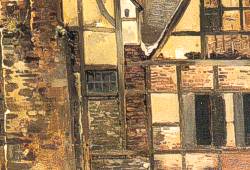 |
|
Detail from a painting by F.A. de Leuw |
|
What happens with an old castle or any other historical wall, if it is protected by law as a National Monument, but nobody really cares about it? The same ending, as happens with any other neglected building. It collapses or, it is torn down to make space for something new, unless a creative idealist can find a way to save it.
- "Why don't you play broker?" - Castle owner without own capital - The idea: Freehold flats - Difficulties ... - Restoration successful - The scandalous barn |
Schloss CaspersbroichHistory of the "democratization" of a precious National Monumentby Claus Gorges In all modesty I can say that I know each corner of Schloss Caspersbroich most intimately, because I was the one who bought it 1964. The Solingen Company Kronprinz owned it that time, and it was in very neglected and run-down condition. |
| |
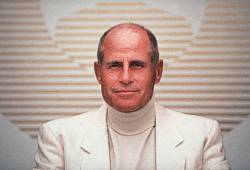 |
|
Castle owner and author Claus Gorges © 1991 Ed Holcomb |
|
|
Kronprinz had purchased the castle around 1960 together with surrounding lands from Baron Boris von Wolf. He had inherited the property from an elderly lady who was considered a little peculiar and was called affectionately the "jecke Grit".
Decision in May 1963.
May 22, 1963 should become a day of fate - not only for me.
|
| |
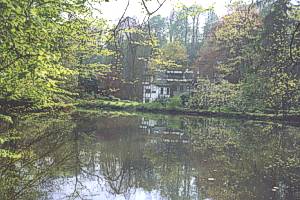 |
|
View over the lake onto Schloss Caspersbroich |
|
|
"Why don't you play broker?"
I was 25 and had, since I was 15, played an Actor taking small parts in large productions and large parts in small productions. After I had finished a three year business and a two year actors training I managed to get the main part in a TV production with the ARD (German TV station). I also did some radio plays with the WDR (one of the major German radio stations).
Beside that were small stuff at the Duesseldorf Schauspielhaus and some large stuff at the Duesseldorf Kammerspiele. And... I didn't like the theater milieu. While really great actors are naturally marvelously humble people, the more modest talented seemed to present themselves like vain peacocks doing their cartwheels. That was not to my taste.
|
|
Castle owner without own capital.
So, when I stood on this sunny fateful day at the castle gate, I had five years experience as a real estate "pro" and was ready to take full responsibility for my first own project. I had no debts but then no capital either. How could I manage to buy under these circumstances this vast estate with castle, farm and romantic park? It would cost millions to restore all this. Day and night I had but one thought: here is where I want to live. But how could I do that without capital?
|
| |
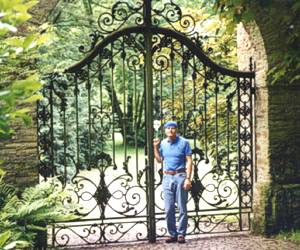 |
|
Ex castle owner Claus Gorges at the gate 32 years later |
|
|
The idea: Freehold flats
In 1963 to 1964 I was the first in Germany to actually restore an old castle by reorganizing it into individual condominiums. Together with an architect from Paris we were also the first in Europe. But he was clever and sold the rooms in his castle, near Orlean, "as is" in an un-restored condition. He took his profit and left his buyers to their fate. Since my personal motivation was to live under the 600 years old beams of the roof, I promised my buyers to transform the old walls into elegant homes. They would have all the comforts they were used to in new buildings: central heating, new electrical installations, modern bathrooms and kitchens and all the other amenities of current life.
|
| |
 |
|
The Knight in the park seemed to keep his protecting hand over the project. |
|
|
Naturally, at that time, I didn't have the faintest notion of what I was getting into. I had to set fixed prices for buyers while I alone would be responsible for the entire repair and remodeling costs. Fortunately I had at least one important ally, the lady in charge of the protection of National Monuments. She had loved the castle since her childhood and was happy to find in me a "madman" who would save it. Since Schloss Caspersbroich did not rank culture-historically among the most precious ones, she gave me freedom and allowed, amongst other things, the insertion of 65 windows in my roof dwelling so that light and sun could flow in.
|
| |
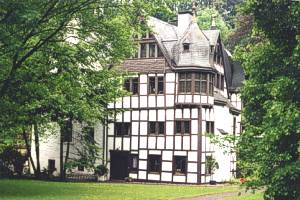 |
|
The restored Schloss Caspersbroich |
|
|
Difficulties ...
But, the difficulties were enormous. At first there was the nine-month search through 16 different banks until I could finally just buy the castle. Next there were the meetings with 260 different parties to sell 6 apartments and to have enough money to cover some of my building expenses. The repair and remodel costs would finally become a cool million and be 110 % over my very amateurish budget. In today's money that would be between 5 and 6 million DM.
|
| |
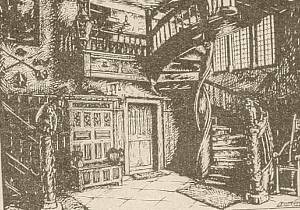 |
|
The entrance hall. © Stadtarchiv Solingen |
|
| |
Restoration successful.
Over time, I turned one unit after another over to their new owners. Looking back it seems like a miracle and I don't know how it happened, that not one single buyer had a single complaint. And God knows, they were wonderful people... but they watched every detail with keen and critical eyes, to make sure that they really got for their money what I had promised them in our contracts. However, not one single complaint.
|
|
| |
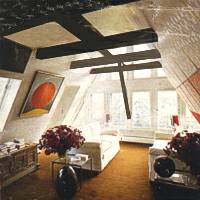 |
|
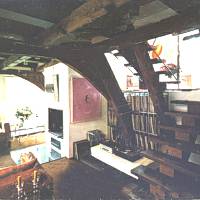 |
|
My apartment under the 600 years old roof | |
|
The former owners were enthusiastic, when they visited the restored castle. Also the famous movie |
| |
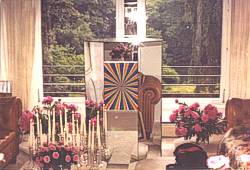 My apartment |
|
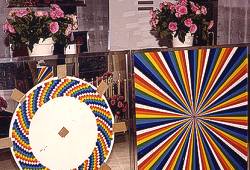 |
|
| |
Later some prominent people chose the charming castle as their residence and others came to visit it. The well-known banker, Alfred Herrhausen was my tenant from 1975 to 1984. He lived in the little Kutscherhaus. I still recall the tragic day in November 1989, when he was assassinated by terrorists. His friend, Helmut Kohl - at that time not yet Bundes Chancellor - had often visited him at Schloss Caspersbroich.
|
|
| |
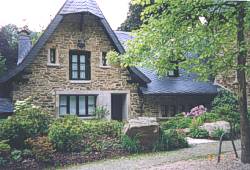 |
|
The Kutscherhaus. This is where Alfred Herrhausen lived from 1975-84. |
|
|
The scandalous barn.
The transformation of the old barn is story, which in retrospect sounds quite amusing, but was at the time dead-serious. If you research the archives of the Solinger Tageblatt, you will find in the years
1972-1974 long reports of the greatest building scandal ever in Solingen.
|
| |
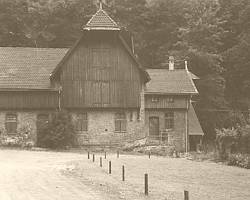 The barn - before ... |
|
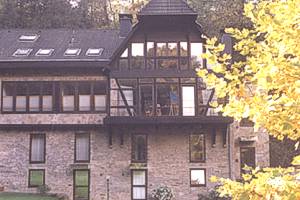 ... and after. |
|
| |
When the raw construction was finished, a clerk (or better a jerk) from the building department showed up, with the originally permitted plans. At first he must have thought he was on the wrong construction site. Then he turned green, yellow, red, threw himself in anger into a water-puddle on the ground. He "red tagged" my building. Oh, oh. Now I was really in trouble. At that time the interest rates for
construction loans were over 14 % and I had already invested over half a million DM.
|
|
| |
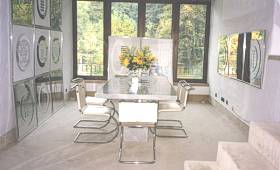 Penthouse in the restored barn: lower level of my gallery with my own I-Ching Mirror Art (1984-1991) |
|
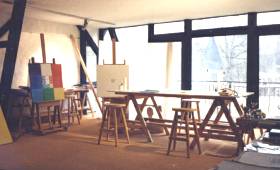 My atelier in the right penthouse |
|
|
I have asked myself often, why these people acted with such animosity? I must have unconsciously triggered a sensitive point. Many might have dreamed of themselves, one day building without a permit, maybe a garage. But, here was somebody who had dared to increase an existing permit by 400 square meters. That must have simply gone beyond their imagination and crashed their tolerance level.
|
| |
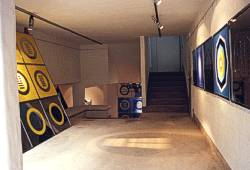 Left penthouse of the restored barn: entrance into the I-Ching Art Gallery ... |
|
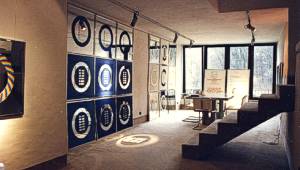 ... with my own I-Ching Mirror Art |
|
|
May 22, 1963, was not only a day of fate for me, but also for Schloss Caspersbroich. The condition of buildings on the entire estate is better today than it has been during its 600 or 700 years old history. If some lunatic doesn't start another war and destroys the castle by bombs or fire, countless generations will be able to admire the beauty of the "old lady" in centuries to come.
But my story would not be complete without mentioning the following. The same May 22, 1963, which was one of the most important and exciting days of my life, was also one of the saddest in the life of a beautiful young lady.
She had been married for only six weeks and her beloved husband passed away in her arms. Nine months later, shortly before I was able to buy Caspersbroich, our destiny brought us together. A year later Lona and
I were married.
|
| |
 |
|
Constantin in 1984. He has his office as an interior designer in Palm Beach, Florida, USA. |
|
|
© 2005 Claus Gorges, Big Sur, California, USA Claus Gorges provided all images to this text to be published on this website. He owns the copyright, if not something else is indicated. |
|
The "old Lady", as Claus Gorges calls Schloss Caspersbroich, has not only gotten a superficial make up, but was lovingly restored from the foundations up to the roof. He lived his "German Dream" from 1966 to 1980 in the castle and from 1984 until 1991 in the barn. He then moved to California where he enjoys his "American Dream" as an artist.
|
|
"Solar Jewelry is the most exciting avant-garde art form of the 21st Century. I plan to present it to our Governor as a low cost deluxe housing alternative, simply designed and made of concrete, steel, and straw with high tech solar elements. Solar Jewelry has the potential to revolutionize our energy supply and to become California's number 1 export. Time will show if the Higher Force, which helped me so many times during the restoration of Schloss Caspersbroich, will continue to hold its protecting hand over my newest visions." |
| |
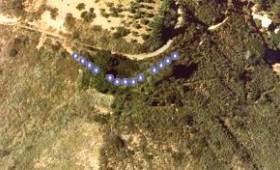 |
|
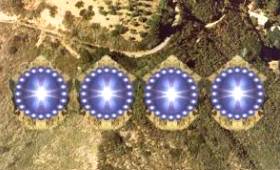 |
|
|
|
www.zeitspurensuche.de
Copyright © 2005 Marina Alice Mutz. Alle Rechte vorbehalten.